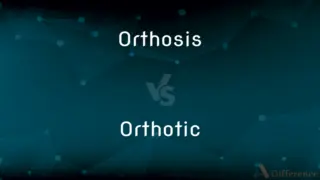Simplicity vs. Simplistic — What's the Difference?
By Maham Liaqat & Fiza Rafique — Updated on April 8, 2024
Simplicity denotes elegance and clarity achieved through focusing on essential aspects, while simplistic suggests oversimplification, often undermining complexity.

Difference Between Simplicity and Simplistic
Table of Contents
ADVERTISEMENT
Key Differences
Simplicity is a quality that embodies elegance, clarity, and focus on what is essential. It often results in outcomes that are easy to understand and interact with, reflecting a deep understanding and thoughtful reduction of complexity. On the other hand, the term simplistic is used to describe something that has been oversimplified to the point where it no longer fully represents the truth or complexity of the subject, suggesting a lack of depth or understanding.
In design, simplicity aims for minimalism and efficiency, removing unnecessary elements to enhance user experience and functionality. Whereas simplistic design may ignore important details or nuances, potentially leading to a product that feels incomplete or not fully thought through.
In arguments or explanations, simplicity can be a virtue. It allows complex ideas to be communicated in an accessible and understandable way, ensuring that the core message is conveyed without unnecessary confusion. Simplistic explanations, however, might skip over critical nuances, leading to misunderstandings or misrepresentations of facts.
When it comes to problem-solving, a simple solution is often seen as elegant, signifying that the solver has cut through the irrelevant and focused on what really matters. Conversely, a simplistic solution may overlook important aspects of the problem, leading to ineffective or temporary fixes that don't address underlying issues.
In storytelling, simplicity can help in creating a powerful and memorable narrative by focusing on key themes and characters, making the story more relatable and impactful. Simplistic storytelling, in contrast, might fail to capture the depth of characters or the complexity of the plot, making the story feel shallow or underdeveloped.
ADVERTISEMENT
Comparison Chart
Definition
Quality of being easy to understand or do
Oversimplified, lacking in depth or detail
In Design
Focuses on essential elements, enhancing functionality
May ignore important details, leading to inefficiency
In Explanation
Makes complex ideas accessible without losing essence
Overlooks complexities, potentially misleading
In Problem-Solving
Seeks elegant solutions that address core issues
Offers superficial fixes that may ignore deeper issues
In Storytelling
Focuses on key themes for impact and relatability
May result in shallow narratives
Compare with Definitions
Simplicity
The state of being natural or unadorned.
She loved the simplicity of rural life.
Simplistic
Approaching problems in a way that ignores complexities.
Their simplistic approach to the crisis was ineffective.
Simplicity
The quality of being understandable or uncomplicated.
The simplicity of the instructions ensured everyone could follow them.
Simplistic
Characterized by oversimplification.
The argument was criticized for being too simplistic.
Simplicity
A feature of something that does not have many parts or details.
The simplicity of the machine made it easy to repair.
Simplistic
Lacking in depth or detail when explaining complex issues.
His simplistic explanation failed to capture the complexity of the situation.
Simplicity
A design principle that emphasizes minimalism and functionality.
The simplicity of the app's design made it popular among users.
Simplistic
Describing something as simpler than it is in reality.
Calling the issue simplistic overlooks the underlying challenges.
Simplicity
The practice of focusing on essential aspects.
His approach to problem-solving was marked by simplicity.
Simplistic
A style or method that simplifies something too much.
The simplistic design of the brochure made it misleading.
Simplicity
Simplicity is the state or quality of being simple. Something easy to understand or explain seems simple, in contrast to something complicated.
Simplistic
Characterized by oversimplification, as in ignoring complexities or complications
Simplistic solutions that would not solve the budget crisis.
Simplicity
The quality or condition of being easy to understand or do
For the sake of simplicity, this chapter will concentrate upon one theory
Simplistic
Usage Problem Simple.
Simplicity
The quality or condition of being plain or uncomplicated in form or design
The grandeur and simplicity of Roman architecture
Simplistic
Overly simple.
Simplicity
The property, condition, or quality of being simple or uncombined.
Simplistic
In a manner that simplifies a concept or issue so that its nuance and complexity are lost or important details are overlooked.
Simplicity
Absence of luxury or showiness; plainness.
Simplistic
Of or pertaining to simples, or a simplist.
Simplicity
Absence of affectation or pretense.
Simplistic
Unrealistically simple
Simplicity
Lack of sophistication or subtlety; naiveté.
Simplicity
Lack of good sense or intelligence; foolishness.
Simplicity
Clarity of expression.
Simplicity
Austerity in embellishment.
Simplicity
The state or quality of being simple
Simplicity
The quality or state of being unmixed or uncompounded
The simplicity of metals or of earths
Simplicity
The quality or state of being not complex, or of consisting of few parts
The simplicity of a machine
Simplicity
Lack of sharpness of mind; lack of ability to think using complex ideas; stupidity
Simplicity
Lack of artificial ornament, pretentious style, or luxury; plainness
Simplicity of dress, of style, or of language
Simplicity of diet
Simplicity of life
Simplicity
Lack of subtlety or abstruseness; clarity
The simplicity of a doctrine
The simplicity of an explanation or a demonstration
Simplicity
Lack of complication; efficiency.
Simplicity
An act or instance of foolishness.
Simplicity
The quality or state of being simple, unmixed, or uncompounded; as, the simplicity of metals or of earths.
Simplicity
The quality or state of being not complex, or of consisting of few parts; as, the simplicity of a machine.
Simplicity
Artlessness of mind; freedom from cunning or duplicity; lack of acuteness and sagacity.
Marquis Dorset, a man, for his harmless simplicity neither misliked nor much regarded.
In wit a man; simplicity a child.
Simplicity
Freedom from artificial ornament, pretentious style, or luxury; plainness; as, simplicity of dress, of style, or of language; simplicity of diet; simplicity of life.
Simplicity
Freedom from subtlety or abstruseness; clearness; as, the simplicity of a doctrine; the simplicity of an explanation or a demonstration.
Simplicity
Weakness of intellect; silliness; folly.
How long, ye simple ones, will ye love simplicity? and the scorners delight in their scorning?
Simplicity
The quality of being simple or uncompounded;
The simplicity of a crystal
Simplicity
A lack of penetration or subtlety;
They took advantage of her simplicity
Simplicity
Absence of affectation or pretense
Simplicity
Freedom from difficulty or hardship or effort;
He rose through the ranks with apparent ease
They put it into containers for ease of transportation
Simplicity
Lack of ornamentation;
The room was simply decorated with great restraint
Common Curiosities
Can simplicity be a design goal?
Yes, simplicity is often a goal in design, aiming to create products that are both aesthetically pleasing and easy to use by focusing on essential features.
What defines simplicity?
Simplicity refers to the quality of being easy to understand or use, often achieved by focusing on essential aspects and minimizing complexity.
How does simplistic differ from simple?
Simplistic means oversimplifying something to the point of losing essential details or depth, while simple emphasizes clarity and effectiveness without unnecessary complexity.
Why is a simplistic approach criticized?
A simplistic approach is criticized because it can overlook important complexities or nuances, leading to misunderstandings or inadequate solutions.
Is simplicity always a virtue?
While simplicity can be a virtue in making concepts accessible and designs user-friendly, it's important to balance it with the need to accurately represent complexities.
How can one achieve simplicity in communication?
Achieving simplicity in communication involves focusing on key messages, avoiding jargon, and organizing information clearly and logically.
What are the risks of a simplistic viewpoint?
A simplistic viewpoint risks oversimplifying issues, leading to solutions or interpretations that don't fully address underlying complexities or realities.
Why might someone prefer a simplistic explanation?
Someone might prefer a simplistic explanation for its ease of understanding, especially in contexts where a detailed comprehension of the topic is not necessary.
How do simplicity and elegance relate?
Simplicity is often associated with elegance, as both involve achieving beauty and effectiveness through the thoughtful reduction and organization of elements.
Is it possible to be too simplistic?
Yes, being too simplistic can be problematic as it may result in overlooking important aspects or failing to adequately solve problems or convey ideas.
How does simplicity relate to minimalism?
Simplicity and minimalism are related concepts, both emphasizing the reduction of unnecessary elements to focus on what is essential, though minimalism often specifically refers to aesthetic design choices.
Can simplicity enhance user experience?
Yes, simplicity can significantly enhance user experience by making products easier to navigate and reducing cognitive load.
How can one distinguish between simple and simplistic in design?
In design, simple refers to clarity and the purposeful use of elements, while simplistic may indicate that a design is lacking in necessary detail or depth.
Can a simplistic solution be effective?
While simplistic solutions may provide a quick fix, they often fail to address deeper issues, potentially leading to longer-term problems.
Does aiming for simplicity mean avoiding complexity?
Aiming for simplicity doesn't mean avoiding complexity; it means presenting complex ideas in a way that is accessible and clear, without unnecessary complication.
Share Your Discovery

Previous Comparison
Landslip vs. Landslide
Next Comparison
Orthosis vs. OrthoticAuthor Spotlight
Written by
Maham LiaqatCo-written by
Fiza RafiqueFiza Rafique is a skilled content writer at AskDifference.com, where she meticulously refines and enhances written pieces. Drawing from her vast editorial expertise, Fiza ensures clarity, accuracy, and precision in every article. Passionate about language, she continually seeks to elevate the quality of content for readers worldwide.












































